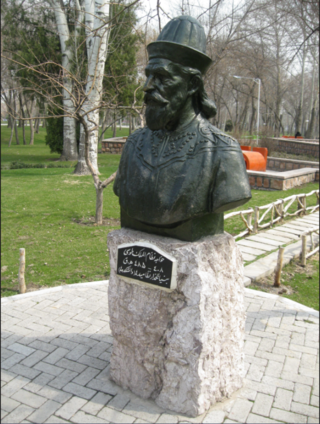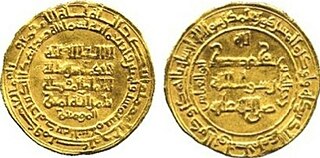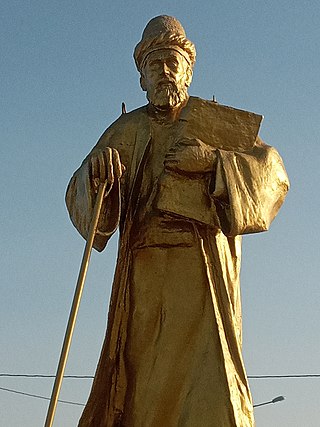
Alp Arslan, born Muhammad bin Dawud Chaghri, was the second sultan of the Seljuk Empire and great-grandson of Seljuk, the eponymous founder of the dynasty. He greatly expanded the Seljuk territory and consolidated his power, defeating rivals to the south and northwest, and his victory over the Byzantines at the Battle of Manzikert, in 1071, ushered in the Turkmen settlement of Anatolia.

Malik-Shah I was the third sultan of the Seljuk Empire from 1072 to 1092, under whom the sultanate reached the zenith of its power and influence.

Abu Ali Hasan ibn Ali Tusi, better known by his honorific title of Nizam ul-Mulk, was a Persian scholar, jurist, political philosopher and vizier of the Seljuk Empire. Rising from a low position within the empire, he became the de facto ruler of the empire for 20 years after the assassination of Sultan Alp Arslan in 1072, serving as the archetypal "good vizier". Viewed by many historians as "the most important statesman in Islamic history", the policies implemented by Nizam ul-Mulk remained the basic foundation for administrative state structures in the Muslim world up until the 20th century.

Abu Talib Muhammad Tughril ibn Mika'il, better known as Tughril, was a Turkoman chieftain, who founded the Seljuk Empire, ruling from 1037 to 1063.

Abū Ja'far Abdallah ibn Aḥmad al-Qādir, better known by his regnal name al-Qā'im bi-amri 'llāh or simply as al-Qā'im; 8 November 1001 – 3 April 1075), was the Abbasid caliph in Baghdad from 1031 to 1075. He was the son of the previous caliph, al-Qadir. Al-Qa'im's reign coincided with the end of the Buyid dynasty's dominance of the caliphate and the rise of the Seljuk dynasty.

Abū'l-Qasim ʿAbd Allāh ibn Muhammad ibn al-Qa'im better known by his regnal name al-Muqtadi was the Abbasid caliph in Baghdad from 1075 to 1094. He succeeded his grandfather caliph al-Qa'im in 1075 as the twenty-seventh Abbasid caliph.
Sayyida Shirin, also simply known as Sayyida (سیدا), was a Bavandid princess, who was the wife of the Buyid amir (ruler) Fakhr al-Dawla.

Abu Kalijar Marzuban was the Buyid amir of Fars (1024–1048), Kerman (1028–1048) and Iraq (1044–1048). He was the eldest son of Sultan al-Dawla.

The Kakuyids were a Shia Muslim dynasty of Daylamite origin that held power in western Persia, Jibal and Kurdistan. They later became atabegs (governors) of Yazd, Isfahan and Abarkuh from c. 1051 to 1141. They were related to the Buyids.

Istakhr was an ancient city in Fars province, five kilometres north of Persepolis in southwestern Iran. It flourished as the capital of the Persian Frataraka governors and Kings of Persis from the third century BC to the early 3rd century AD. It reached its apex under the Sasanian Empire, and was the hometown of the Sasanian dynasty. Istakhr briefly served as the first capital of the Sasanian Empire from 224 to 226 AD and then as principal city, region, and religious centre of the Sasanian province of Pars.

Rukn al-Din Abu'l-Muzaffar Berkyaruq ibn Malikshah, better known as Berkyaruq (برکیارق), was the fifth sultan of the Seljuk Empire from 1094 to 1105.
Shabankara or Shwankara was an Iranian tribe. They claimed descent from the mythical Iranian king Manuchehr who had been deported to eastern Fars from Isfahan by the Buyid Shahanshah 'Adud al-Dawla. The dynasty's capital was Ij (Ig) and was divided in six districts: Zarkān, Iṣṭabānān, Burk-Tārum-K̲h̲ayra, Nayriz, Kurm-Rūnīz-Lār, and Darabjird. The tribe had the following subdivisions: Ismāʿīlī, the Rāmānī, the Karzuwī, the Masʿūdī and the S̲h̲akānī who were all herders and warriors.

The Hazaraspids or Atābakān-e Lor-e Bozorg were a Kurdish dynasty that ruled the Zagros Mountains region of southwestern Iran, essentially in Lorestan and which flourished in the later Saljuq, Ilkhanid, Muzaffarid, and Timurid periods.
Abu Mansur Fulad Sutun was the last Buyid amir of Fars, ruling more or less continuously from 1048 until his death. He was the son of Abu Kalijar.

Kara Arslan Ahmad Qavurt, better simply known as Qavurt was a Seljuq prince. Upon his brother's death, he led an unsuccessful rebellion against his nephew in an attempt to gain the Seljuk throne.

Amid al-Mulk Abu Nasr al-Kunduri, commonly known as al-Kunduri, was a Persian bureaucrat, who served as the vizier of the first Seljuk Sultan Tughril and his nephew Alp Arslan.

The Kerman Seljuk Sultanate was a Persianate Sunni Muslim state, established in the parts of Kerman and Makran which had been conquered from the Buyid dynasty by the Seljuk Empire which was established by the Seljuk dynasty, which was of Oghuz Turkic origin. The Founder of this dynasty, Emadeddin Kara Arslan Ahmad Qavurt who succeeded the ruler of this dynasty after the surrender of the ruler of Buyyids, Abu Kalijar Marzuban. For first time in this period, an independent state was formed in Kerman; eventually, after 150 years, with the invasion of the Ghuzz leader Malik Dinar, the Kerman Seljuk Sultanate fell.
Fakhr al-Mulk was a Persian bureaucrat, who served as the vizier of the Seljuk sultan Berkyaruq from 1095 to 1099, and later vizier of the Sejluk prince and ruler of Khurasan, Ahmad Sanjar, from 1101 to 1106. He was the eldest son of the prominent Seljuk vizier Nizam al-Mulk.

Badr ibn Hasanwayh was the second ruler of the Hasanwayhids from 979 to 1014. He was the son and successor of Hasanwayh.
Sa'd ad-Dawla Gohar-Ā'īn was an 11th-century Turkic eunuch mamluk who served as a government official, diplomat, and military commander for the Seljuk Empire. The name "Gohar-Ā'īn" means "jewel-mirror". Medieval authors had differing opinions about him – Ibn al-Jawzi spoke highly of him, praising "his capability, clear view, and leadership of the army" as well as his "piousness, uprightness and justice". Ibn al-Athir also had a positive opinion of him, saying he "did not take anything for himself from the people of his wilaya". Bundari, on the other hand, spoke negatively of him, calling him "cunning like a dog, something like a beast, a man without penis, a woman without vagina".















